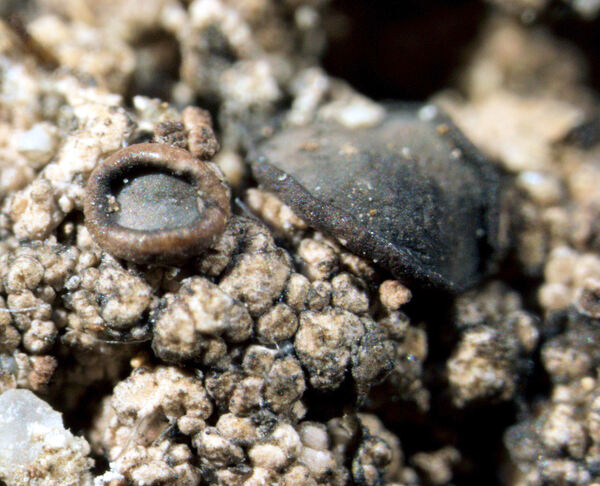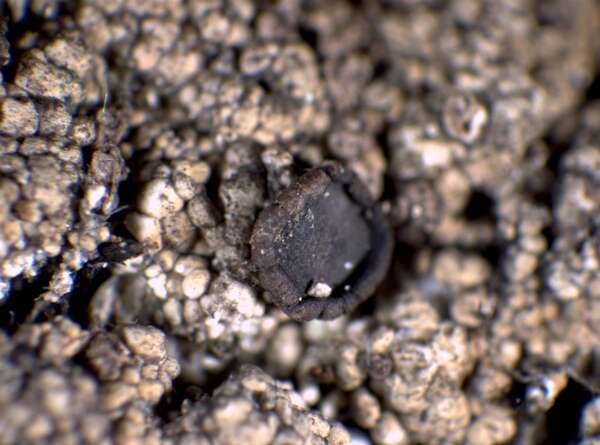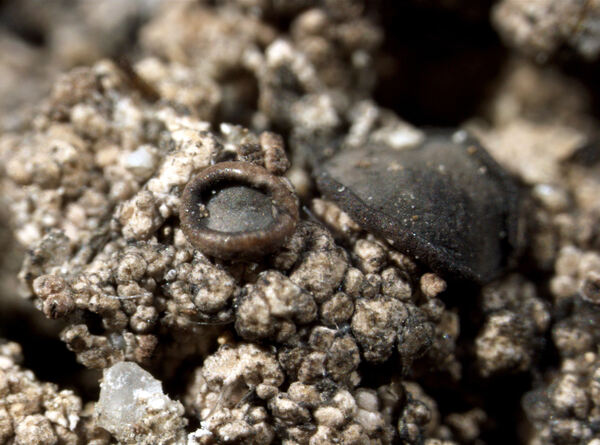Ainoa geochroa (Körb.) Lumbsch & I. Schmitt
in Lumbsch & al., Mycol. Res., 105, 3: 272, 2001. Basionym: Biatora geochroa Körb. - Parerga Lichenol., 2: 151, 1860
Synonyms: Buellia punctiformis var. muscicola Anzi; Lecidea geochroa (Körb.) Lettau; Trapelia geochroa (Körb.) Hertel
Distribution: N - Lomb.
Description: Thallus crustose, episubstratic, granular-verrucose, whitish, consisting of 0.4-1.6 mm wide, initially flat, later hemispherical and more or less hollow, easily breakable warts. Medulla white, I-. Apothecia lecideine, sessile and strongly constricted at base, 0.7-2(-3.5) mm across, single to confluent, with a slightly concave to slightly convex, brown to black-brown, rough disc, and a rather thick, flexuose to crenulate proper margin which is pale brown in lower part, black-brown in upper part. Proper exciple 40-80 µm wide, cupulate, dark brown, of long-celled and thick-walled hyphae, C+ pink; epithecium colourless to brownish; hymenium colourless, 90-150 µm high, C+ pink; paraphyses sparingly branched, 0.8-1.2 µm thick, easily separated; hypothecium pale brown in upper part, darker brown in lowermost part. Asci 8-spored, cylindrical-clavate, thin-walled, the apical dome K/I- or K/I+ pale blue, Trapelia-type. Ascospores 1-celled, hyaline, narrowly ellipsoid, 15-32 x 6-14 µm. Pycnidia 0.5-0.8 mm across, immersed in thalline warts, C+ pink. Conidia narrowly bacilliform, 5-6 x c. 0.7 µm. Photobiont chlorococcoid. Spot tests: thallus K-, C-, KC-, P- (but the primordia of apothecia and the parts surrounding the pycnidia reacting C+ red); apothecial sections and pycnidia C+ pink. Chemistry: gyrophoric acid in apothecia and pycnidia.Note: on fresh acidic mineral soil in open vegetation developing in areas with a long snow cover (Solorinion croceae-communities); distribution in the Alps poorly known, perhaps overlooked.
Growth form: Crustose
Substrata: soil, terricolous mosses, and plant debris
Photobiont: green algae other than Trentepohlia
Reproductive strategy: mainly sexual
Commonnes-rarity: (info)
Alpine belt: very rare
Subalpine belt: extremely rare
Oromediterranean belt: absent
Montane belt: absent
Submediterranean belt: absent
Padanian area: absent
Humid submediterranean belt: absent
Humid mediterranean belt: absent
Dry mediterranean belt: absent

Predictive model
Herbarium samples
Growth form: Crustose
Substrata: soil, terricolous mosses, and plant debris
Photobiont: green algae other than Trentepohlia
Reproductive strategy: mainly sexual
Commonnes-rarity: (info)
Alpine belt: very rare
Subalpine belt: extremely rare
Oromediterranean belt: absent
Montane belt: absent
Submediterranean belt: absent
Padanian area: absent
Humid submediterranean belt: absent
Humid mediterranean belt: absent
Dry mediterranean belt: absent

Predictive model
| Herbarium samples |
 INDEX FUNGORUM
INDEX FUNGORUM
 GBIF
GBIF






